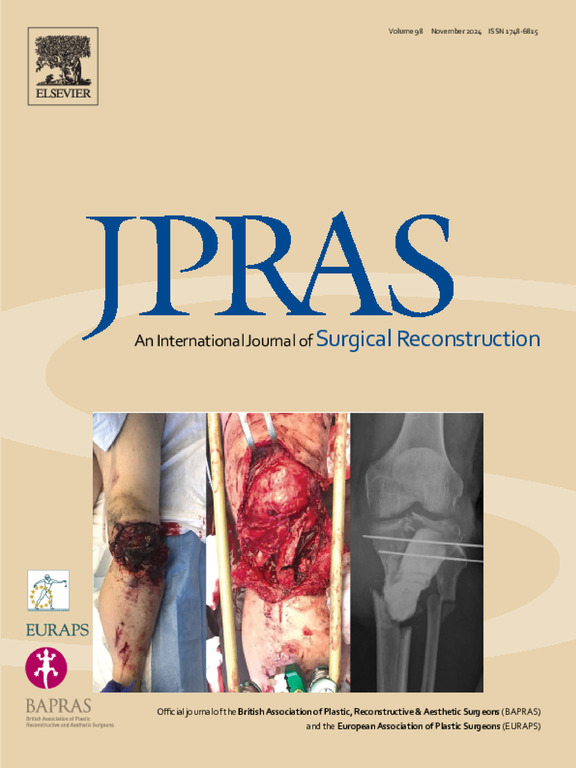闭式切口负压伤口治疗腹部自体乳房重建术的疗效:系统回顾和meta分析
IF 2.4
3区 医学
Q2 SURGERY
Journal of Plastic Reconstructive and Aesthetic Surgery
Pub Date : 2025-07-01
DOI:10.1016/j.bjps.2025.06.032
引用次数: 0
摘要
以腹部为基础的游离组织移植,如腹下穿支皮瓣(DIEP),在自体乳房重建中被广泛应用。这些手术通常因供体部位的伤口愈合问题而复杂化,包括伤口裂开、血清形成和手术部位感染(ssi)。闭合切口负压伤口治疗(ciNPWT)被认为可以改善愈合效果并减少术后并发症的发生率。该综合评估了ciNPWT与标准敷料在腹部自体乳房重建中的疗效。方法按照PRISMA指南进行系统评价和荟萃分析。随机对照试验和观察性研究评估了ciNPWT与标准敷料在腹部自由皮瓣乳房重建患者中的应用。主要和次要结果分析为伤口裂开、ssi、血肿形成和住院时间。使用Review Manager 5.4和Microsoft Excel对来自多个数据库的数据进行独立评审和综合。对研究进行了严格的选择和偏倚风险评估。结果在348篇纳入的文献中,13项研究符合纳入标准,包括3项随机对照试验和10项观察性研究,共计2882例患者。ciNPWT组伤口裂开减少42% (OR 0.58, 95% CI 0.42-0.79;p = 0.0007),异质性中等(I²= 36%)。手术部位感染无显著差异(OR 0.77, 95% CI 0.50-1.18;p = 0.23)和血清形成(OR 0.66, 95% CI 0.38-1.12;P = 0.15)。停留时间数据的差异妨碍了定量分析。结论cinpwt可显著减少创面裂开,突出了其在加强术后护理方面的价值,特别是对高危患者。然而,为了充分阐明ciNPWT在减少其他并发症方面的作用及其更广泛的临床适用性,还需要开展更大规模、多中心随机对照试验的进一步研究。本文章由计算机程序翻译,如有差异,请以英文原文为准。
Efficacy of closed-incision negative pressure wound therapy in abdominal-based autologous breast reconstruction: A systematic review and meta-analysis
Introduction
Abdominal-based free tissue transfers, such as the Deep Inferior Epigastric Perforator (DIEP) flap, are widely utilized in autologous breast reconstruction. These procedures are often complicated by wound healing issues at the donor site, including wound dehiscence, seroma formation, and surgical site infections (SSIs). Closed Incision Negative Pressure Wound Therapy (ciNPWT) has been suggested to improve healing outcomes and reduce the incidence of postoperative complications. This synthesis evaluated the efficacy of ciNPWT compared to standard dressings in abdominal-based autologous breast reconstruction.
Methods
A systematic review and meta-analysis were conducted following PRISMA guidelines. Randomized controlled trials and observational studies assessing ciNPWT versus standard dressings in patients undergoing abdominal-based free flap breast reconstruction were included. Primary and secondary outcomes analyzed were wound dehiscence, SSIs, seroma formation, and length of stay. Data from multiple databases were independently reviewed and synthesized using Review Manager 5.4 and Microsoft Excel. Studies were rigorously selected and assessed for risk of bias.
Results
Of the 348 identified articles, 13 studies met the inclusion criteria, comprising three randomized controlled trials and 10 observational studies, totaling 2882 patients. The ciNPWT group showed a 42% reduction in wound dehiscence (OR 0.58, 95% CI 0.42–0.79; p = 0.0007), with moderate heterogeneity (I² = 36%). No significant differences were found for surgical site infections (OR 0.77, 95% CI 0.50–1.18; p = 0.23) and seroma formation (OR 0.66, 95% CI 0.38–1.12; p = 0.15). Variations in length of stay data prevented quantitative analysis.
Conclusion
ciNPWT demonstrates a significant reduction in wound dehiscence, highlighting its value in enhancing postoperative care, especially for high-risk patients. However, further research involving larger, multicenter randomized controlled trials is necessary to fully elucidate ciNPWT's role in reducing other complications and its broader clinical applicability.
求助全文
通过发布文献求助,成功后即可免费获取论文全文。
去求助
来源期刊
CiteScore
3.10
自引率
11.10%
发文量
578
审稿时长
3.5 months
期刊介绍:
JPRAS An International Journal of Surgical Reconstruction is one of the world''s leading international journals, covering all the reconstructive and aesthetic aspects of plastic surgery.
The journal presents the latest surgical procedures with audit and outcome studies of new and established techniques in plastic surgery including: cleft lip and palate and other heads and neck surgery, hand surgery, lower limb trauma, burns, skin cancer, breast surgery and aesthetic surgery.

 求助内容:
求助内容: 应助结果提醒方式:
应助结果提醒方式:


